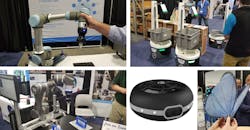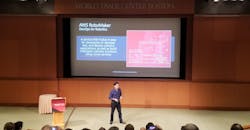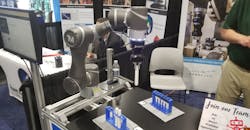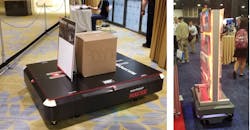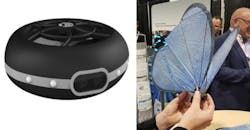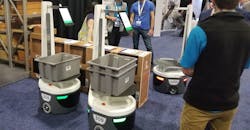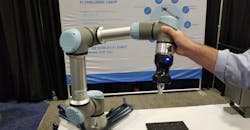Robotics Summit Offers a Different Look at Robots
Sometimes robotics shows are like a box of chocolates—you never know what you’re goin’ t’get. Of course, plenty of robots at the Robotics Summit & Expo were wandering the floor or flying about. Many shows like the Consumer Electronics Show (CES) present robots, but this conference takes a look under the hood. It includes a design and development track for robotic applications and a technology tools and platforms track.
The lead keynote was from Joshua Ness, Senior Manager at Verizon 5G Labs. His topic, “Why Innovators are Flocking to 5G (And What You Should Do About It),” was the first divergence from the conventional robots shows that are often talking about cobots or robots in the warehouse. Of course, 5G is being touted at the key technology for everything from video streaming to smart cities and self-driving cars. The higher bandwidth and lower latency will be very useful for robots and robotic applications as well.
Roger Barga, General Manager with AWS Robotics and Autonomous Services at Amazon Web Services (AWS), was talking about “The Role of the Cloud in the Future of Robotics” (Fig. 1). This involves two key aspects. First is using the cloud for development. The second is connecting robots to the cloud. For the former, there’s AWS RoboMaker. This cloud service makes it easy to develop, test, and deploy intelligent robotics applications. RoboMaker builds on the Robot Operating System (ROS), a popular open-source robotics software framework. For the latter, the cloud allows for coordinating multiple robots in settings such as hospitals and warehouses so that robots don’t have to handle planning and execution in isolation. The cloud can make robotic coordination much easier.
1. 5G and the cloud were topics at this year’s Robot Summit. Here, Roger Barga, General Manager, AWS Robotics and Autonomous Services, Amazon Web Services, talked about “The Role of the Cloud in the Future of Robotics.”
I saw one of Omron’s cobots doing some simulated experimentation (Fig. 2). The robotic arm actually comes without a gripper. Third parties have hundreds of grippers designed to handle different applications. The robotic arms have built-in vision support with optional support for two external gigabit Ethernet cameras. It also supports Modbus TCP/RTU.
2. Cobots developed by Omron are easy to train and can handle precision tasks like manipulating test samples.
Robots like Waypoint Robotics’ autonomous platforms help move items around with warehouses and other facilities. Its Vector platforms can handle up to 600 lb. with omnidirectional wheels. The software is based on ROS, making it possible for developers to customize the systems. Waypoint Robotics’ provides its own software like Dispatcher Expert for setup and management, and Whistle, a common-sense robot control service for requesting and directing autonomous robots. Also, the company's new MAV3K robot has a 3000-lb payload capacity (Fig. 3).
3. Waypoint Robotics can deliver custom, autonomous robots that carry heavy loads (left). We also saw some robots delivering collateral to attendees (right).
Cleo Robotics was showing off a compact, autonomous drone called Cleo (Fig. 4). The propeller is self-contained so that it won’t harm anyone or get caught in other objects. It has built-in obstacle detection using LiDAR and optical recognition, and it supports automatic altitude control. A VGA camera provides real-time feedback.
4. Cleo Robotics’ Cleo is a compact reconnaissance drone designed for indoor use (left). Festo was showing off some microdrones that mimic the flight characteristics of insects (right).
Festo was on hand as well. The company provides everything from hydraulic grippers to industrial automation robots. For instance, Festo had a simple, inexpensive electric gripper replacement for hydraulic grippers as many sites are moving away from hydraulic systems.
The firm also likes to show off its technology, including a few drones based on insects like the butterfly in Fig. 4. It also brought along a four-wing dragonfly that was a bit larger.
Locus Robotics was showing off its LocusBot designed for warehouses (Fig. 5). The robot is fast but unobtrusive. The latest one adds a blue headlight so that forklift operators working with these cobots can more readily observe the LocusBots, which are slightly smaller than an adult. The compact robotic design includes a touchpad for interacting with users, who can then send off the autonomous robots to finish their chores. The touchpad can also be used for directed picking where the robot indicates to a worker where an item can be found that can then be placed into the robot’s basket.
5. The LocusBot solution from Locus Robotics targets warehouse operations. The touchpad allows users to interact with the robot.
The last in this summary was Universal Robotics’ (UR) cobot arm (Fig. 6). UR’s servo controllers precisely track the amount of current used by a servo to determine whether the arm has come in contact with another object like a person. UR has robotic arms that can handle 3, 5, and 10 kg.
6. Universal Robots robotic arms track the power used by the servos when moving the arm to determine if another object, like a person, is in contact with the robot.
About the Author
William G. Wong
Bill Wong is senior content director for Electronic Design.
